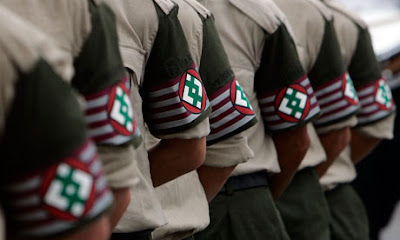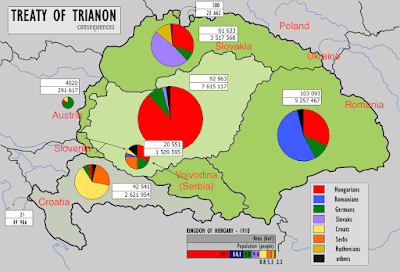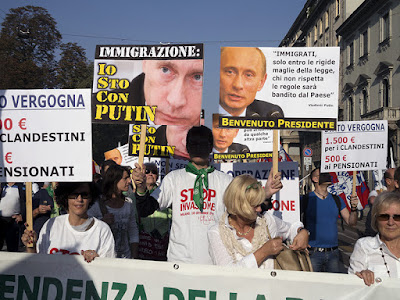We are used to international geopolitics inserting itself into the world of association football (that’s “soccer” to Americans). World powers sometimes use the game as a proxy war for their own tussles over what is and is not a state and where national borders lie. Examples include the ban on holding FIFA games in Russian-occupied
Crimea,
Spain trying to block
Gibraltar, which it still claims, from member-state status, and ongoing politically motivated fan violence in Balkan hotspots like
Bosnia and
Kosovo. But now a smaller football league that was supposed to be aloof from the rougher political edges of
FIFA (the French acronym for the
International Federation of Association Football) is courting similar controversy.
This league, the
Confederation of Independent Football Associations (
ConIFA), a new organization devoted to aspirant or unrecognized states ineligible for FIFA membership,
decided this summer that its 2016 football (soccer) world cup would be held in the
Republic of Abkhazia, a
de facto–independent Russian puppet state in what most of the world outside
Russia regards as part of the
Republic of Georgia. Despite damage and economic instability resulting from a recent history of separatist war and ongoing diplomatic limbo, Abkhazia and its capital city, Sukhumi, can, ConIFA promises, offer “top-class infrastructure” for a sporting event. But Abkhazia is bound to be a divisive choice, considering that Russian support for violent separatism in
Ukraine since early last year—a political situation which closely parallels Abkhazia, which split away as the Cold War ended—has led to calls to boycott the Russian-hosted FIFA World Cup planned for 2018.
ConIFA is not the first league of its type. A predecessor was
Viva, which doesn’t stand for anything but is a play on the name FIFA, also set up for national teams of unrecognized states. Viva’s first world cup, in 2006, was originally to be held in the
Turkish Republic of Northern Cyprus, a puppet state that every country in the world other than
Turkey recognizes as part of the
Republic of Cyprus. Northern Cyprus ended up ceding hosting duties to
Occitania (southern
France) after a brouhaha over Northern Cypriot demands to vet participating teams—probably the result of Turkish skittishness at that time about any kind of recognition of any kind of Kurdish entity, since northern
Iraq’s autonomous
Kurdistan Region was also a participant. Viva has successfully kept politics out of the team-selection process in the four subsequent Viva cup finals hosted by, in turn,
Sápmi (the northern Scandinavian homeland of the
Sami, or
Lappish, people),
Padania (separatist northern
Italy),
Gozo (the
Republic of Malta’s smaller island), and Erbil, the Iraqi Kurdish capital.
![]() |
| Sami (Lapp) footballers competing in Östersund |
Other participating Viva teams over the years have included
Monaco (not a pseudo-state, but too small for FIFA nonetheless),
Provence,
Zanzibar,
Arameans Soryoye (the team of the Christian
Syriac people),
Darfur (southwestern
Sudan),
Raetia (the linguistically distinct
Ladin,
Friulian, and
Romansh speakers of southeast
Switzerland and northern
Italy),
Tamil Eelam (the Hindus of northern
Sri Lanka), and
Western Sahara (the
Moroccan-occupied
Sahrawi homeland). Customs red tape and other logistical problems have mostly prevented
Southern Cameroons,
West Papua, and
Tibet from participating. But no one was deliberately excluding anyone, or being remotely provocative. Even the Northern Cypriot team graciously conceded defeat to the Kurdish team in the 2012 Erbil games.
(Yet another organization,
FIFI (
Federation of International Football Independents), in 2006 held a one-off exhibition “Wild Cup” tournament in Hamburg,
Germany, where Northern Cyprus triumphed over Zanzibar, Gibraltar,
Greenland, Tibet, and the
Republic of St. Pauli—this last being a fictive micronation (fictive even by micronational standards) consisting of Hamburg’s red-light district.)
The ConIFA European cup this June, for its part, was hosted in
Hungary by
Székely Land, a proposed state in western
Romania’s ethnic-Magyar (Hungarian) region.
Padania (northern
Italy) won that 11-match series, with the
County of Nice (in southeastern
France), the
Isle of Man, and
Felvidék (
Slovakia’s “
Upper Hungary” region) ranking second through fourth, in that order. The first ConIFA world cup, in 2014 in Östersund,
Sweden, hosted by
Sápmi (
Lappland), was won by the highly impressive Niçois team.
![]() |
| Magyar nationalists displaying the Székely Land flag in Transylvania |
And here, with this ConIFA line-up, the observant reader who is familiar with the minor nationalisms to which this blog is devoted will have caught perhaps a clue as to why Abkhazia, of all places, was selected to host the 2016 ConIFA cup. Start with Székely Land, an autonomist cause with nowhere near the popular momentum enjoyed by, say,
Scotland,
Catalonia (both of which keep a plenty high profile in FIFA football), Padania, Kurdistan, or Tibet. In fact, the idea of giving autonomy to the Magyar-dominated parts of western Romania is mostly a pet cause of the extremist far right in Hungary and Romania (
as discussed once in this blog). Autonomy for Romania’s Szeklers (Magyars) is in particular an abiding emotional rallying point for
Jobbik, the neo-fascist ultranationalist party in Hungary, which in an election last year became Hungary’s third-largest party.
![]() |
| Jobbik armbands on parade |
Felvidék, or “Upper Hungary,” the formerly Hungarian-ruled parts of Slovakia, is an even obscurer cause. Slovakia is a stable, increasingly western-style state, and Hungarian is an official language in areas where speakers are more than 20% of the population. (They are 8.5% of it nationwide.) Slovakia’s Magyars are hardly separatist, but Jobbik has not forgotten them. The party specifically calls for the revocation of the 1920 Treaty of Trianon. That agreement, part of the dismantling of the defeated
Austro-Hungarian Empire after the First World War, whittled the newly independent Hungary down to its current size, stripping away territories that had been under the Hungarian crown within the empire: all of Slovakia, a third or so of modern Romania, the
Vojvodina province of northern
Serbia, Ukraine’s
Transcarpathia oblast, and significant territories which are now along the edges of
Austria,
Slovenia, and
Croatia. Jobbik wants all these lands back. Only small bits of them have ethnic-Hungarian majorities today, but under Habsburg rule the German-speaking Austrian and Magyar élites ruled over smaller ethnonational groups in a political structure that was almost feudal. Hungary, when it was an Axis country during the Second World War, tried and failed to use that conflict to regain lost territories.
![]() |
Light green is modern Hungary;
darker green are those areas stripped from
the Kingdom of Hungary after the First World War |
The County of Nice, too, is mostly a right-wing, even neo-fascist, irredentist cause. In the years of conflict leading up to Italian unification in the mid 19th century, this Mediterranean city and its environs were ceded by the
Kingdom of Sardinia’s
House of Savoy (soon to become the ruling house of unified Italy) to France in exchange for help fighting the Austrians. This stuck in the craw of the unification hero
Giuseppe Garibaldi, a Niçois native who once famously said, “If Nice is French, then I am a
Tatar.” Thus Nice shifted from a mostly Italian-speaking city to a francophone one. A claim on Nice was revived by
Benito Mussolini during the Fascist era, and it is also included by the far-right, xenophobic, anti-Brussels
Lega Nord (
Northern League) in northern Italy as part of its dreamed-of “
Greater Padania.” Oh, and of course Padania is prominent in ConIFA too (as it was in Viva). A ConIFA delegation to Nice in May of this year
is prominently featured on the ConIFA website.
![]() |
| Football fans waving the Niçois separatist flag |
Abkhazia, next year’s ConIFA host, is one of two ethnically distinct parts of Georgia which split away from Georgia after the fall of Communism in the early 1990s—the other being
South Ossetia, which, like Abkhazia, is also a ConIFA member “state.” After the brief South Ossetia War in 2008, Russia’s President
Vladimir Putin shored up their
de facto independence and granted them diplomatic recognition, something only a handful of other tiny states have followed the Russian example in extending. Abkhazia and South Ossetia are in fact just the longest-standing parts of an archipelago of Russian-backed puppet states in non-Russian parts of the former
Union of Soviet Socialist Republics. Others (discussed at length elsewhere in this blog, e.g.
here) are
Transnistria, in
Moldova; the
Armenian-dominated
Nagorno-Karabakh Republic in
Azerbaijan (the N.K.R. is also in ConIFA); the
Donetsk and
Luhansk “
People’s Republics” established last year in eastern Ukraine; and, less concretely, possible future separatist entities in places like Transcarpathia (see discussions in this blog
here and
here), Ukraine’s
Odessa oblast (see reports from this blog
here and
here), and ethnic-Russian parts of
Kazakhstan, the Baltic States, and elsewhere. Another emotional issue for Armenian nationalists and their Turkophobic puppetmasters in the Kremlin is is another ConIFA “member,”
Western Armenia, a proposed N.K.R.-type entity many Armenians would like to carve out of what is now eastern
Turkey. (Turkey is a member of the
North Atlantic Treaty Organization (
NATO) and has been a bugbear of Russian nationalists since Ottoman days. Turkey and Azerbaijan are both allies of the U.S.)
Transnistria, it will be no surprise, is also a target of ConIFA diplomacy, in the form of
an official ConIFA visit just before June’s European cup to Tiraspol, capital of this tiny, Russian-backed sliver of a pseudostate consisting of Moldova’s eastern edge abutting Ukraine. ConIFA would like Transnistria to host a future tournament. It also features prominently in contingent Russian plans for a takeover of more of the southern, ethnic-Russian-dominated areas of Ukraine, which mostly extend in a belt across the northern shores of the Black Sea, extending to Odessa oblast, which borders Transnistria.
![]() |
| Transnistrians in Bessarabian folk costume in a flag ceremony in Tiraspol |
Putin’s proxy expansionism, while it exploits Soviet iconography and terms like “people’s republic,” is in fact a right-wing type of enterprise, and to this end it is not surprising that it has gained the support of far-right parties in the west that might otherwise talk a lot about “freedom”—such as (
see discussion in this blog) Jobbik, Lega Nord,
Flemish separatists in
Belgium, libertarian-leaning separatists in Venice, the
United Kingdom Independence Party (
UKIP), and high-profile right-wing conspiracy-mongering nuts in the
United States such as
Lyndon LaRouche and
Ron Paul. Putinism shares with these far-right movements a suspicion of the
European Union (
E.U.), NATO, and multilateralism in general; xenophobia focusing on a nakedly bigoted Islamophobia; and an infatuation with muscular militant nationalist leadership that in fact has more in common with 1930s Fascism than with Soviet-style Communism.
![]() |
| Putin is a darling of xenophobic Padanist separatists like these Lega Nord activists in Milan |
To be sure, leftist aspirant states are in ConIFA too, including the
Aymará indigenous nation of
Bolivia; the disinherited
Chagos Islanders of
Diego Garcia in the Indian Ocean, who live in exile in
England; and
Cascadia in the American and
Canadian Pacific Northwest. But even some of these are causes which appeal to Putin’s anti-Western imperialism.
The Aymará nation includes Bolivia’s left-wing president,
Evo Morales, who sided with Putin’s invasion and annexation of Crimea. Bolivia was one of only ten countries which sided with Russia in voting against a March 2014 United Nations resolution that upheld Ukraine’s right to territorial integrity following the Crimea annexation; the others—all of them (
as discussed at the time in this blog) mostly profoundly undemocratic societies—were Armenia,
North Korea,
Zimbabwe,
Cuba,
Nicaragua,
Venezuela,
Syria,
Sudan, and
Belarus. Even
Iran,
China, and
Myanmar had the decency to at least abstain. The Chagos Islanders’ cause, too (see discussion
here and
here), is one which Putin is keen to highlight because it is an example of a serious human-rights abuse which can be laid at the feet of NATO. Along with the prominence of the above-discussed obscure neo-fascist irrendentist entities like Upper Hungary, Székely Land, and Nice, most of the teams prominent in ConIFA are ones that conform to the anti-Western, anti-NATO, anti-E.U. agenda of Putin’s new imperialism in its “near abroad.”
![]() |
| Aymará Indian demonstrators with their national flag |
One possible result of a tournament in Abkhazia next year, and a possible later one in Transnistria, would be to spread the popularity and prestige of the Russian puppet-state model among separatist groups across the political spectrum and around the world—fitting the new pattern of parties like Lega Nord, France’s National Front, and Jobbik—even the otherwise-leftist Basque nationalists in Spain—lining up behind Putin’s imperialist agenda in Crimea, Georgia, Moldova, and Ukraine. Playing in Abkhazia is sure to be willfully misinterpreted as a
de facto recognition by these aspirant nations. It is worth asking who is running ConIFA—or, perhaps, who has taken it over or whom it serves. While Putin plays hardball in Ukraine, the lurch to the right in separatist soccer may be one of his stealth “soft power” offensives.
[You can read more about Abkhazia, Transnistria, and many other separatist and new-nation movements, both famous and obscure, in my new book, a sort of encyclopedic atlas just published by Litwin Books under the title Let’s Split! A Complete Guide to Separatist Movements and Aspirant Nations, from Abkhazia to Zanzibar. The book, which contains 46 maps and 554 flags (or, more accurately, 554 flag images), is available for order now on Amazon. Meanwhile, please “like” the book (even if you haven’t read it yet) on Facebook and see this interview for more information on the book.]














